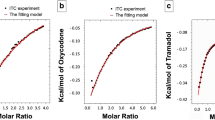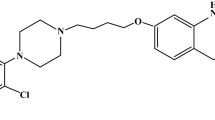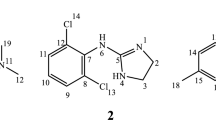Abstract
The objective of this research was to investigate physicochemical properties of an active pharmaceutical ingredient (API) that influence cyclodextrin complexation through experimental and computational studies. Native β-cyclodextrin (B-CD) and two hydroxypropyl derivatives were first evaluated by conventional phase solubility experiments for their ability to complex four poorly water-soluble nonsteroidal anti-inflammatory drugs (NSAIDs). Differential scanning calorimetry was used to confirm complexation. Secondly, molecular modeling was used to estimate Log P and aqueous solubility (S o) of the NSAIDs. Molecular dynamics simulations (MDS) were used to investigate the thermodynamics and geometry of drug-CD cavity docking. NSAID solubility increased linearly with increasing CD concentration for the two CD derivatives (displaying an AL profile), whereas increases in drug solubility were low and plateaued in the B-CD solutions (type B profile). The calculated Log P and S o of the NSAIDs were in good concordance with experimental values reported in the literature. Side chain substitutions on the B-CD moiety did not significantly influence complexation. Explicitly, complexation and the associated solubility increase were mainly dependent on the chemical structure of the NSAID. MDS indicated that each NSAID-CD complex had a distinct geometry. Moreover, complexing energy had a large, stabilizing, and fairly constant hydrophobic component for a given CD across the NSAIDs, while electrostatic and solvation interaction complex energies were quite variable but smaller in magnitude.








Similar content being viewed by others
References
Dahan A, Miller JM, Amidon GL. Prediction of solubility and permeability class membership: provisional BCS classification of the world’s top oral drugs. AAPS J. 2009;11:740–6.
Fu Q, Kou LF, Gong C, Sun J, He ZG, et al. Relationship between dissolution and bioavailability for nimodipine colloidal dispersions: the critical size in improving bioavailability. Int J Pharm. 2012;427:358–64.
Plakkot S, de Matas M, York P, Saunders M, Sulaiman B. Comminution of ibuprofen to produce nano-particles for rapid dissolution. Int J Pharm. 2011;415:307–14.
Pokharkar VB, Malhi T, Mandpe L. Bicalutamide nanocrystals with improved oral bioavailability: in vitro and in vivo evaluation. Pharm Dev Technol. 2013;18:660–6.
Zhang JJ, Huang YT, Liu DP, Gao Y, Qian S. Preparation of apigenin nanocrystals using supercritical antisolvent process for dissolution and bioavailability enhancement. Eur J Pharm Biopharm. 2013;48:740–7.
Basalious EB, El-Sebaie W, El-Gazayerly O. Application of pharmaceutical QbD for enhancement of the solubility and dissolution of a Class II BCS drug using polymeric surfactants and crystallization inhibitors: development of controlled-release tablets. AAPS PharmSciTech. 2011;12:799–810.
Ribeiro ME, de Moura CL, Vieira MG, Gramosa NV, Ricardo NM, et al. Solubilisation capacity of Brij surfactants. Int J Pharm. 2012;436:631–5.
Machatha SG, Bustamante P, Yalkowsky SH. Deviation from linearity of drug solubility in ethanol/water mixtures. Int J Pharm. 2004;283:83–8.
Seedher N, Kanojia M. Co-solvent solubilization of some poorly-soluble antidiabetic drugs. Pharm Dev Technol. 2009;14:185–92.
Forster A, Hempenstall J, Tucker I, Rades T. Selection of excipients for melt extrusion with two poorly water-soluble drugs by solubility parameter calculation and thermal analysis. Int J Pharm. 2001;226:147–61.
Leuner C, Dressman J. Improving drug solubility for oral delivery using solid dispersions. Eur J Pharm Biopharm. 2000;50:47–60.
Brewster ME, Loftsson T. Cyclodextrins as pharmaceutical solubilizers. Adv Drug Deliv Rev. 2007;59:645–66.
Holvoet C, Heyden YV, Plaizier-Vercammen J. Inclusion complexation of lorazepam with different cyclodextrins suitable for parenteral use. Drug Dev Ind Pharm. 2005;31:567–75.
Loftsson T, Hereinsdottir D, Masson M. Evaluation of cyclodextrin solubilization of drugs. Int J Pharm. 2005;302:18–28.
Saetern AM, Nguyen NB, Bauer-Brandl A, Brandl M. Effect of hydroxypropyl-B-cyclodextrin complexation and pH on solubility of camptothecin. Int J Pharm. 2004;284:61–8.
Mallick S, Mondal A, Sannigrahi S. Kinetic measurements of the hydrolytic degradation of cefixime: effect of Captisol complexation and water-soluble polymers. J Pharm Pharmacol. 2008;60:833–41.
Ozdemir N, Erkin J. Enhancement of dissolution rate and bioavailability of sulfamethoxazole by complexation with beta-cyclodextrin. Drug Dev Ind Pharm. 2012;38:331–40.
Trapani A, Lopedota A, Denora N, Trapani G, Liso G, et al. A rapid screening tool for estimating the potential of 2-hydroxypropyl-beta-cyclodextrin complexation for solubilization purposes. Int J Pharm. 2005;295:163–75.
Yang J, Wiley CJ, Godwin DA, Felton LA. Influence of hydroxypropyl-beta-cyclodextrin on transdermal penetration and photostability of avobenzone. Eur J Pharm Biopharm. 2008;69:605–12.
Felton LA, Wiley CJ, Godwin DA. Influence of hydroxypropyl-B-cyclodextrin on the transdermal permeation and skin accumulation of oxybenzone. Drug Dev Ind Pharm. 2002;28:1117–24.
Godwin DA, Wiley CJ, Felton LA. Using cyclodextrin complexation to enhance secondary photoprotection of topically applied ibuprofen. Eur J Pharm Biopharm. 2006;2:85–93.
Kear CL, Yang J, Godwin DA, Felton LA. Investigation into the mechanism by which cyclodextrins influence transdermal drug delivery. Drug Dev Ind Pharm. 2008;34:692–7.
Loftsson T, Brewster ME. Cyclodextrins as functional excipients: methods to enhance complexation efficiency. J Pharm Sci. 2012;101:3019–32.
Tongiani S, Ozeki T, Stella VJ. Sulfobutyl ether-alkyl ether mixed cyclodextrin derivatives with enhanced inclusion ability. J Pharm Sci. 2009;98:4769–80.
Kou W, Cai CF, Xu SY, Wang H, Zhang TH, et al. In vitro and in vivo evaluation of novel immediate release carbamazepine tablets: complexation with hydroxypropyl-beta-cyclodextrin in the presence of HPMC. Int J Pharm. 2011;409:75–80.
Lee YH, Sathigari S, Lin YJ, Ravis WR, Babu RJ, et al. Gefitinib-cyclodextrin inclusion complexes: physico-chemical characterization and dissolution studies. Drug Dev Ind Pharm. 2009;35:1113–20.
Sinha VR, Anitha R, Ghosh S, Nanda A, Kumria R. Complexation of celecoxib with beta-cyclodextrin: characterization of the interaction in solution and in solid state. J Pharm Sci. 2005;94:676–87.
Uzqueda M, Martin C, Zornoza A, Sanchez M, Velaz I, et al. Characterization of complexes between naftifine and cyclodextrins in solution and in the solid state. Pharm Res. 2006;23:980–8.
Kratz JM, Teixeira MR, Ferronato K, Teixeira HF, Simoes CM, et al. Preparation, characterization, and in vitro intestinal permeability evaluation of thalidomide-hydroxypropyl-beta-cyclodextrin complexes. AAPS PharmSciTech. 2011;13:118–24.
Palem CR, Battu SK, Gannu R, Yamsani VV, Yamsani MR, et al. Role of cyclodextrin complexation in felodipine-sustained release matrix tablets intended for oral transmucosal delivery: in vitro and ex vivo characterization. Pharm Dev Technol. 2011;17:321–32.
Chari R, Qureshi F, Moschera J, Tarantino R, Kalonia D. Development of improved empirical models for estimating the binding constant of a beta-cyclodextrin inclusion complex. Pharm Res. 2009;26:161–71.
Li H, Sun J, Wang Y, Sui X, Sun L, Zhang JJ, et al. Structure-based in silico model profiles the binding constant of poorly soluble drugs with B-cyclodextrin. Eur J Pharm Sci. 2011;42:55–64.
Higuchi T, Connors KA. Phase-solubility techniques. In: Reilley CN, editor. Advances in analytical chemistry and instrumentation. New York: John Wiley & Sons, Inc; 1965. p. 117–212.
Omile CI, Tebbett IR, Danesh B. Determination of ten anti-inflammatory drugs in serum by isocratic liquid chromatography. Chromatographia. 1986;22:187–8.
Loftsson T, Hereinsdottir D, Masson M. The complexation efficiency. J Incl Phenom Macrocycl Chem. 2007;57:545–52.
Gundogdu E, Koksal C, Karasulu E. Comparison of cefpodoxime proxetil release and antimicrobial activity from tablet formulations: complexation with hydroxypropyl-beta-cyclodextrin in the presence of water soluble polymer. Drug Dev Ind Pharm. 2012;38:689–96.
Mihajlovic T, Kachrimanis K, Graovac A, Djuric Z, Ibric S. Improvement of aripiprazole solubility by complexation with (2-hydroxy)propyl-beta-cyclodextrin using spray drying technique. AAPS PharmSciTech. 2012;13:623–31.
Wojciechowski ML, Lesyng B. Generalized born model: analysis, refinement, and applications to proteins. J Phys Chem B. 2004;108:18368–76.
Lin A. QuaSAR-descriptor. 2012.
Wildman SA, Crippen GM. Prediction of physiochemical parameters by atomic contributions. J Chem Inf Comput Sci. 1999;39:868–73.
Pedraza A, Sicilia MD, Rubio S, Perez-Bendito D. Pharmaceutical quality control of acid and neutral drugs based on competitive self-assemply in amphiphilic systems. Analyst. 2006;131:81–9.
Drugbank.ca. June 6, 2013.
Salustio PJ, Feio G, Figueirinhas JL, Pinto JF, Marques HM. The influence of the preparation methods on the inclusion of model drugs in a beta-cyclodextrin cavity. Eur J Pharm Biopharm. 2009;71:377–86.
Loftsson T, Magnusdottir A, Masson M, Sigurjonsdottir JF. Self-association and cyclodextrin solubilization of drugs. J Pharm Sci. 2002;91:2307–16.
Hopfinger AJ, Yang L, Liu J. The binding of drugs and small biological molecules to carbon naotubes as a possible source of nanotoxicity. Mol Pharm. 2009;6:873–82.
Perlovich GL, Skar M, Bauer-Brandl A. Driving forces and the influence of the buffer composition on the complexation reaction between ibuprofen and HPCD. Eur J Pharm Sci. 2003;20:197–200.
Acknowledgments
Funding for this work was supported in part by Roquette Freres. Computational facilities from both Exe Research LLC and The Chem21 Group, Inc. were made available in order to perform the modeling and molecular dynamics simulation studies reported in this paper.
Author information
Authors and Affiliations
Corresponding author
Rights and permissions
About this article
Cite this article
Felton, L.A., Popescu, C., Wiley, C. et al. Experimental and Computational Studies of Physicochemical Properties Influence NSAID-Cyclodextrin Complexation. AAPS PharmSciTech 15, 872–881 (2014). https://doi.org/10.1208/s12249-014-0110-2
Received:
Accepted:
Published:
Issue Date:
DOI: https://doi.org/10.1208/s12249-014-0110-2




